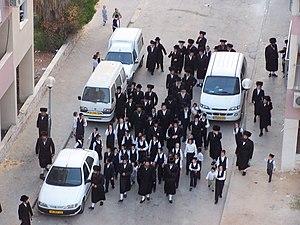
According to halacha, the operation of a motor vehicle constitutes multiple violations of the prohibited activities on Shabbat (the Jewish Sabbath). Though Jewish law is based on texts that were written long before the existence of the automobile, when driving one performs various actions which the texts specifically prohibit.
For example, the vehicle's ignition combusts fuel, which is considered to violate one of the 39 melachot, as well as creating a spark, which is likewise in violation of a related rabbinic (or possibly biblical) prohibition ("igniting a fire").[1][2][3] Modern vehicles also have many other electrical components, such as lights, that are turned on and off during the course of a vehicle's operation, often without the driver's awareness. Isaiah 58:13–14 calls on Jews to limit their travel during Shabbat, and the law of techum shabbat puts limits on the distance one may travel beyond the city/town where one is spending Shabbat, regardless of the method of transportation.[4]
However, many non-Orthodox Jews have taken differing views on the matter, finding various reasons to permit and justify at least some driving on Shabbat, either solely for synagogue attendance or for other personal reasons as well. Ignoring Orthodox Jewish law, some feel that driving involves less effort than walking, while others feel that those who live too far from a synagogue would be cut off from religious life altogether if they do not drive to reach the synagogue, and the benefits outweigh full Shabbat observance.[5] Other sources reject any defense of driving during Shabbat, arguing that to reject the prohibition would be a rejection of a God-given commandment.
According to both Orthodox and non-Orthodox Jews, driving on Shabbat is permitted (and required) when necessary to save a human life (pikuach nefesh).
- ^ Neulander, Arthur. "The Use of Electricity on the Sabbath." Proceedings of the Rabbinical Assembly 14 (1950) 165–171.
- ^ Adler, Morris; Agus, Jacob; and Friedman, Theodore. "Responsum on the Sabbath." Proceedings of the Rabbinical Assembly 14 (1950), 112–137.
- ^ Klein, Isaac. A Guide to Jewish Religious Practice. The Jewish Theological Seminary of America: New York, 1979.
- ^ Rabbi Mendy Hecht. "How far am I allowed to walk on Shabbat?". Rabbis Answer Torah Questions 24/6.
- ^ Jane Golub & Joel Lurie Grishaver. Zot Ha-Torah. p. 99.
